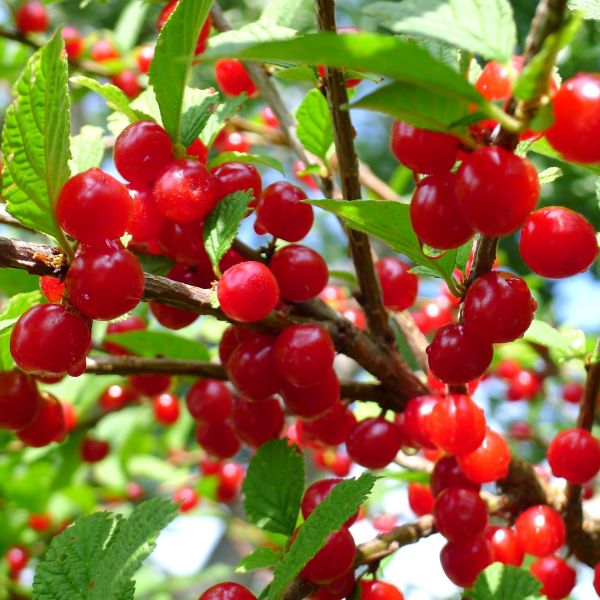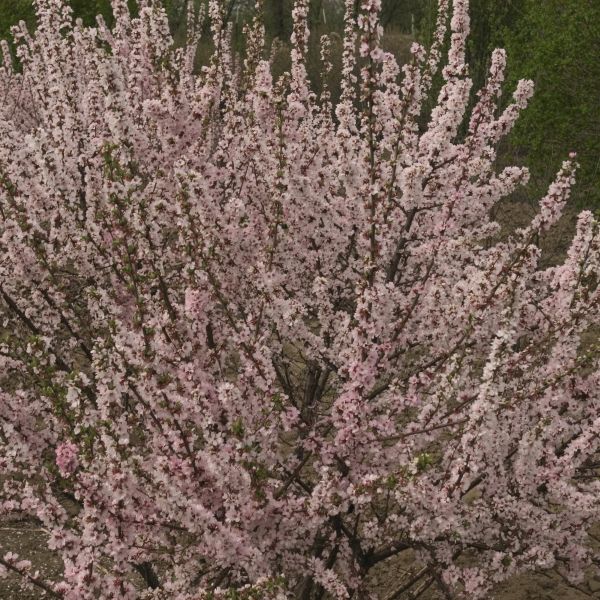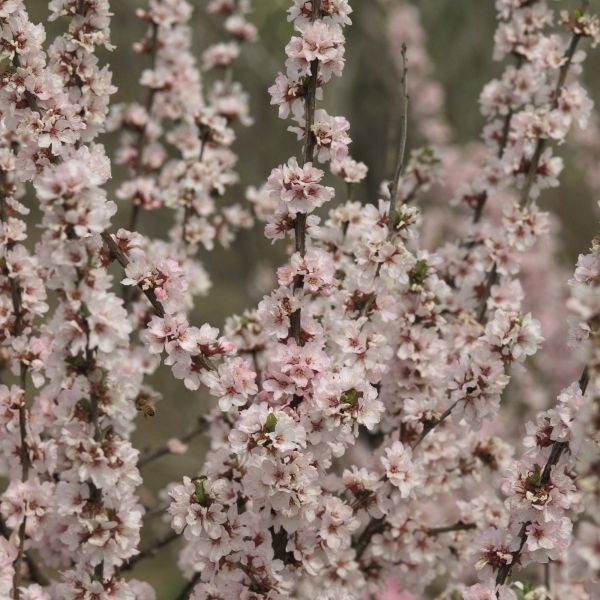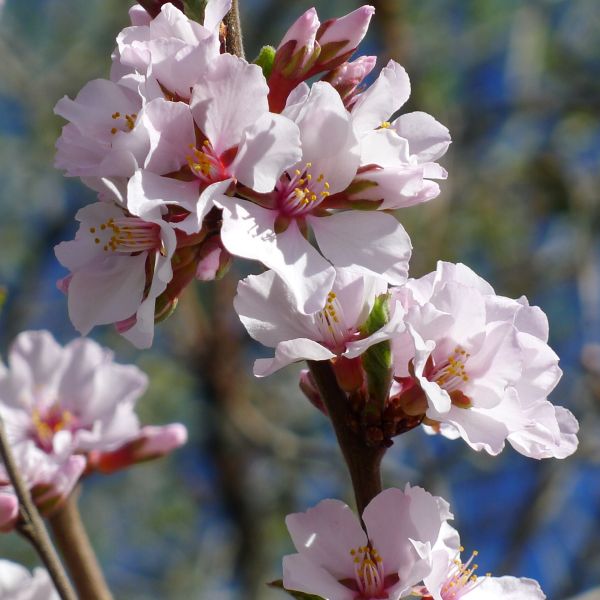Nanking Cherry Tree
Prunus tomentosa
Plant Sentry™
Plant Sentry™

Plant Sentry™ Protected
Your order is protected by our compliance system that:
- Prevents restricted plants from shipping to your state
- Ensures plants meet your state's agricultural requirements
- Protects gardens from invasive pests and diseases
Delivery and Shipping
Delivery and Shipping
Delivery and Shipping
Fast, Safe Plant Delivery
Ships in 3-4 business days • Tracking provided • Weather protected
| Under $50 | $9.99 |
| $50 - $99.99 | $14.99 |
| $100 - $149.99 | $16.99 |
| $150 - $198.99 | $24.99 |
| $199+ | FREE |
✓ Zone-specific timing • ✓ Professional packaging • ✓ Health guarantee
Understanding Plant Options
Nature Hills offers plants in two main formats:
- Container Plants: Grown in pots with soil, sized by container volume and plant age
- Bare Root Plants: Dormant plants without soil, sized by height measurements
Container Plant Sizes
Container sizes indicate plant age and growing capacity rather than liquid volume equivalents. Our containers follow industry-standard nursery "trade gallon" specifications, which differ from standard liquid gallon measurements.
Young Plants (6 months to 18 months old)
| Container Size | Actual Volume | Metric Equivalent |
|---|---|---|
| 2" x 2" x 3" | 0.18 - 0.21 dry quarts | 0.20 - 0.23 dry liters |
| 4" Container | 0.31 - 0.87 dry quarts | 0.35 - 0.96 dry liters |
| 4.5" Container | 0.65 dry quarts | 0.72 dry liters |
| 6" Container | 1.4 dry quarts | 1.59 dry liters |
| 1 Quart | 1 dry quart | 1.1 dry liters |
| 5.5" Container | 1.89 dry quarts | 2.08 dry liters |
Established Plants (18 months to 2.5 years old)
| Container Size | Actual Volume | Metric Equivalent |
|---|---|---|
| 2 Quart | 2 dry quarts | 2.2 dry liters |
| #1 Container | 2.26 - 3.73 dry quarts | 2.49 - 4.11 dry liters |
| 5" x 5" x 12" | 3.5 - 4.3 dry quarts | 3.85 - 4.74 dry liters |
Mature Plants (2-4 years old)
| Container Size | Actual Volume | Metric Equivalent |
|---|---|---|
| #2 Container | 1.19 - 1.76 dry gallons | 5.24 - 7.75 dry liters |
| #3 Container | 2.15 - 2.76 dry gallons | 8.14 - 12.16 dry liters |
Large Plants (3-5 years old)
| Container Size | Actual Volume | Metric Equivalent |
|---|---|---|
| #5 Container | 2.92 - 4.62 dry gallons | 12.86 - 20.35 dry liters |
| #6 Container | 5.25 - 6.01 dry gallons | 23.12 - 26.42 dry liters |
| #7 Container | 5.98 - 6.53 dry gallons | 26.34 - 28.76 dry liters |
Bare Root Plants
Bare root plants are sold by height from the root system to the top of the plant. Plants may exceed minimum height requirements.
Common Sizes:
- Trees: 1 foot, 2 feet, 3 feet, 4 feet, 5 feet, 6 feet
- Shrubs & Perennials: 1 foot, 18 inches, 2 feet
Important Notes
Container Volume Specifications
- Trade Gallon Standard: Our containers follow industry-standard "trade gallon" specifications established by the American National Standards Institute (ANSI Z60.1) for nursery stock
- Volume Variations: Actual soil volume may vary due to plant root systems and growing medium settlement
- Age Indicators: Container size primarily indicates plant age and maturity rather than liquid volume equivalents
Growing Conditions
- Plant size can vary based on variety and growing conditions
- Container size helps indicate plant maturity and establishment level
- Larger containers generally mean more established root systems and faster landscape establishment
Seasonal Availability
- Bare root plants are available seasonally when dormant
- Container plants are available throughout the growing season
- Specific varieties may have limited availability in certain sizes
Questions?
For questions about specific plant sizes or availability, please contact our plant experts who can help you choose the right size for your landscape needs.

Plant Sentry™ Protected
Your order is protected by our compliance system that:
- Prevents restricted plants from shipping to your state
- Ensures plants meet your state's agricultural requirements
- Protects gardens from invasive pests and diseases
Plant Profile & Growing Essentials
Cold hardy, Flowering, Edible, Ornamental Berries/Fruit, Hedge/Screen, Drought resistant, and Attracts pollinators
Specifications
Specifications
-
Botanical Name
-
Height
-
Width
-
Growing Zones
-
Sunlight
-
Growth RateModerate
-
Flower Color
-
Leaf Color
-
Fall Color
-
Pollinator FriendlyYes
-
Pollinator Required
-
FragrantYes
-
Bloom PeriodEarly Spring
Planting & Care Instructions
Planting & Care Instructions
Cold-Hardy Sour Cherry Nanking Cherry Tree
- Beautiful, Hardy Edible Ornamental Shrub
- Profusion of Fragrant White Flowers in Early Spring
- Tasty, Abundant Bright Red Fruit
- Wide Shrub or Small Tree
- Extremely Cold Tolerant
- Use as a Special Hedge or Specimen
- Pest and Disease Resistant
- Tolerant of Periodic Drought
- Feed Songbirds or Harvest Nanking Cherries for Pies, Jelly and Wine
- Great Choice for Nature Lovers and Foodies in Cold Climates
For homeowners in the cold winter zones from 2 - 6, Nanking Cherry (Prunus tomentosa) is a wonderful, easy-care bush to add to the landscape. You'll love the fruit's tangy, sweet-tart taste for fresh eating or baking into pies.
The spring flowers are spectacular! Rosy pink buds cover the shrub in early spring, and open to showy white flowers. This reliable early bloomer is so welcome after the long winter.
The flowers are both fragrant and frost tolerant, which makes this plant a true harbinger of spring. Of course, the white blooms are also a welcome nectar source for butterflies and pollinators.
Nanking Cherry has a long history of proving delicious red fruit in harsh climates. The berries seem to glow against the attractive, textured foliage. Each cherry is a brilliant, translucent red jewel.
Use it as a long hedge along a fence or a single specimen. Or, create an orchard in a backyard homestead. This is the earliest Cherry to flower, and it produces an abundance of tasty cherries.
Nanking Cherry is not reliably self-fertile. To achieve fruit set, plant two or more shrubs close by each other to ensure proper cross-pollination for the best fruit production.
Plan to start harvest as they ripen in early to mid-summer, depending on your location. Or, just leave them for your local bird population. It's a win-win either way!
We'll tempt you to harvest some for yourself, as many people swear by the Nanking for wine and mead production. Or, use it to craft beautiful clear jellies and wonderful jams. You'll find pages of recipes for Nanking Cherry on the Internet. It would take years just to try them all.
The highly-textured, quilted, dark green, toothed leaves are decorative in their own right. They are downy on the underside. The soft-textured foliage turns a soothing yellow in the fall.
Even the bark is beautiful, lustrous and ornamental. It delivers visual interest in winter as it exfoliates to show pattern variation of shiny reddish-brown bark peeling to orange as it ages.
This is a great conversation plant with fragrant blooms, attractive soft green foliage and wonderful bright red fruit. In time, this plant develops a picturesque rounded form in the landscape. Order today!
How to Use Nanking Cherry in the Landscape
Use it for massing in a hedge or planted on a slope. Include it in your mixed borders as a lovely backdrop for smaller plants. Or, plant two or three shrubs together for a fabulous fruiting specimen to create a marvelous focal point in a lawn planting.
The soft features make it the perfect accent along a driveway or running along a fence. Add it to windbreaks for color, fragrance, fruit and to add charm and personality.
Nanking Cherry has tremendous value for screening and hedging. Plant them 6 - 8 feet apart to create a free-form, natural hedge. Measure from the center of the first shrub to the center of the next.
If desired, the Nanking Cherry can be pruned into a single trunk tree, or a multi-trunk specimen for a focal point in the landscape.
For a special treat in mid-winter, cut several branches and bring them indoors. You can force them to bloom in sunny spot. Just arrange the branches in a tall vase and change the water daily. You'll thrill to seeing the buds open indoors.
Easily create a wildlife habitat with several Nanking Cherry bushes added to anchor a Butterfly Garden. The birds, butterflies and pollinators will thank you!
#ProPlantTips for Care
This plant is very well-known in the Asian Far East, where it's found in most home gardens and on commercial plantations throughout Russia. A heavy usage means there are a lot of common names. You might hear Downy Cherry, Mountain or Mongolian Cherry, Hedge Cherry, Chinese Bush Cherry or Manchu Cherry.
Whatever you call it, it's a hard-working landscape plant with a lot of ornamental features. This tough plant is really useful in areas where hardy plants are required, but few are available. Nanking Cherry is the earliest-blooming Cherry and one of the best producers for extreme temperature areas.
Brought to the United States in 1882, the plant’s cold hardiness, early-blooming along with its natural dwarfing, were all considered exciting traits.
The yummy fruit is too soft for most commercial purposes, and is not often available any other way than growing your own. Eat them fresh, or prepare into pie filling, make jams or jelly or freeze them.
The Nanking Cherry adapts to a variety of soil conditions and pH levels. Give it a full sun location and well-drained soil for best results. Be careful to water it regularly while the plant is young.
Nanking can handle periodic drought, once it's established in your native soil. This is a great choice for semi-arid climates with cold winters and hot summers.
Prune Nanking Cherry to thin out dead and diseased branches after fruiting is done. Open the center of the plant to sunshine and air circulation each year.
If you are looking for a plant that is beautiful, helps wildlife, and can give you fruit as well, this is a great choice. Order Nanking Cherry today.
Historical, Beautiful, Nutritious Sour Cherry Selection
The Nanking Cherry may be one of the most diverse fruiting plants known. This is a true edible ornamental that has been cultivated for 1000's of years throughout eastern Asia. It combines the fine qualities of a beautiful flowering shrub and tremendously healthy fruit - all growing on a plant that will withstand some of the harshest climates known.
The Nanking Cherry, also known as Prunus tomentosa, is a native sour cherry variety found in China, Korea, Mongolia, and surrounding areas. Although typically classified with the sour cherries, the Nanking Cherry has good sweetness and rarely is too sour to eat fresh.
Nanking Cherry comes true from seed, so there can be a little difference in flavor or hardiness depending on where the mother plant originated. Used in Asia primarily for the abundant flower and the nutritious fruit, the plant's dependable fruit production made it a staple in the Asian diet.
Though the Nanking Cherry looks like a cherry, it is actually closer related to a plum. Because of this, P. tomentosa has been used as a dwarfing rootstock for peaches, plums, and some cherries for many years. Although, more recent research has determined that the Nanking Cherry should only be used for dwarfing certain selections, due to a shorter tree life and lesser production issues.
Introduced into the United States in 1892 by the Arnold Arboretum at Harvard University, the Nanking Cherry's many qualities were quickly recognized. Most obvious was the hardiness of the plant, which drew the attention of cold climate growers across the nation. The plant was particularly adapted to the upper Midwest's cold winters and hot dry summers.
By 1935, it was considered a potential commercial crop for these regions with cultivars being introduced from the University of Minnesota. This never materialized, and the developed cultivars have all been lost.
However, the Nanking Cherry's popularity in the home garden market grew tremendously. The plants great adaptability to USDA Zones 2 - 7, and the ability to tolerate drought conditions, were key to the variety's popularity. The edible and ornamental aspects of this tree only add to the demand.
Little maintenance is required to establish this plant as a hedge or windbreak. A wonderful, fragrant spring flower display followed by the early fruit set adds to the home garden value.
Nanking Cherry is a nutritious fruit high in Vitamin C and antioxidants. The fruit is best eaten fresh but is also used to make jams and juices. The Nanking Cherry has also been a popular tree among the Bonsai community in Japan and is becoming popular with Bonsai enthusiasts in the United States today.















